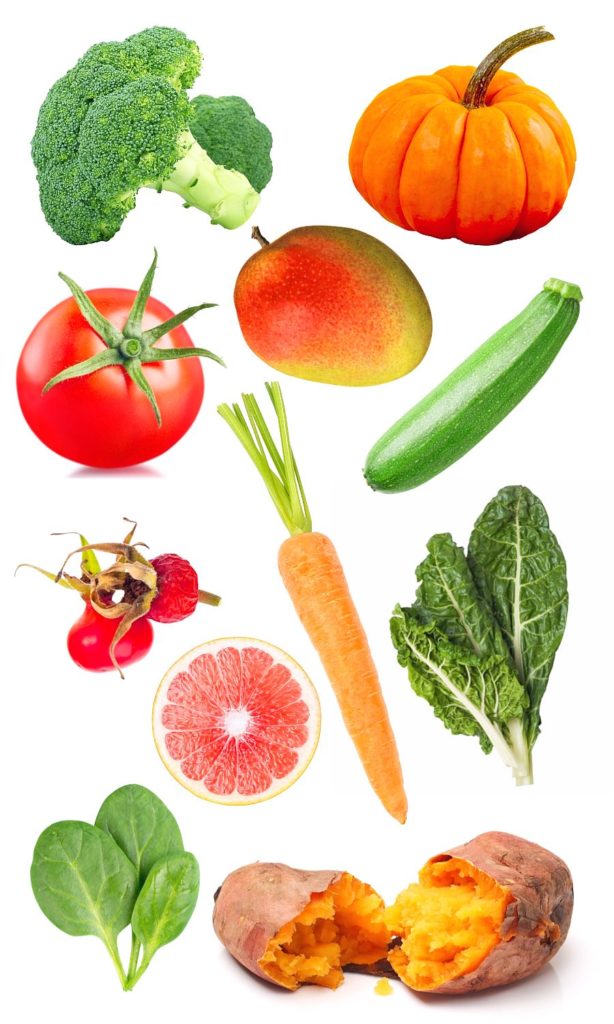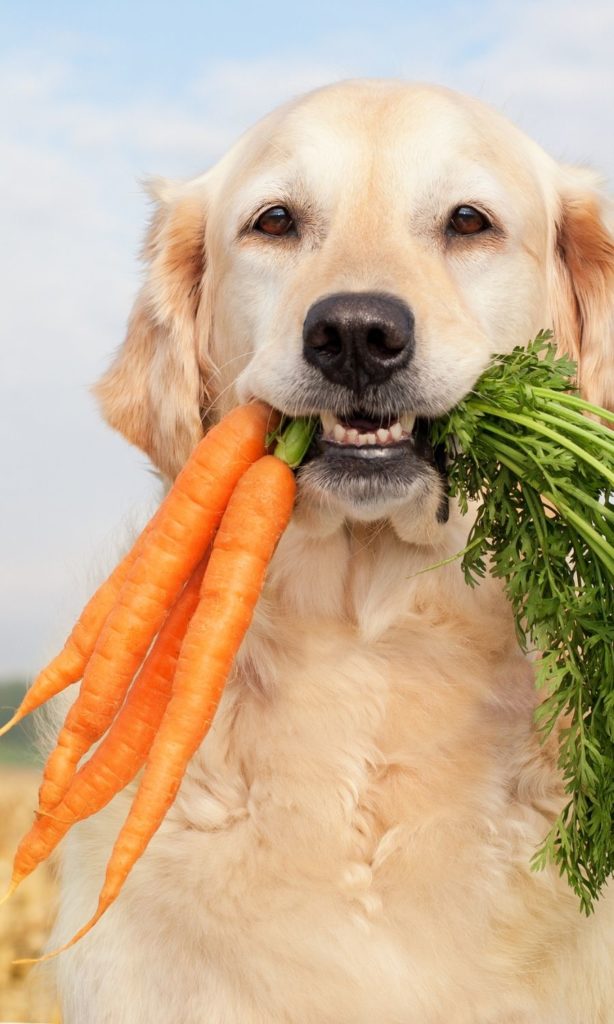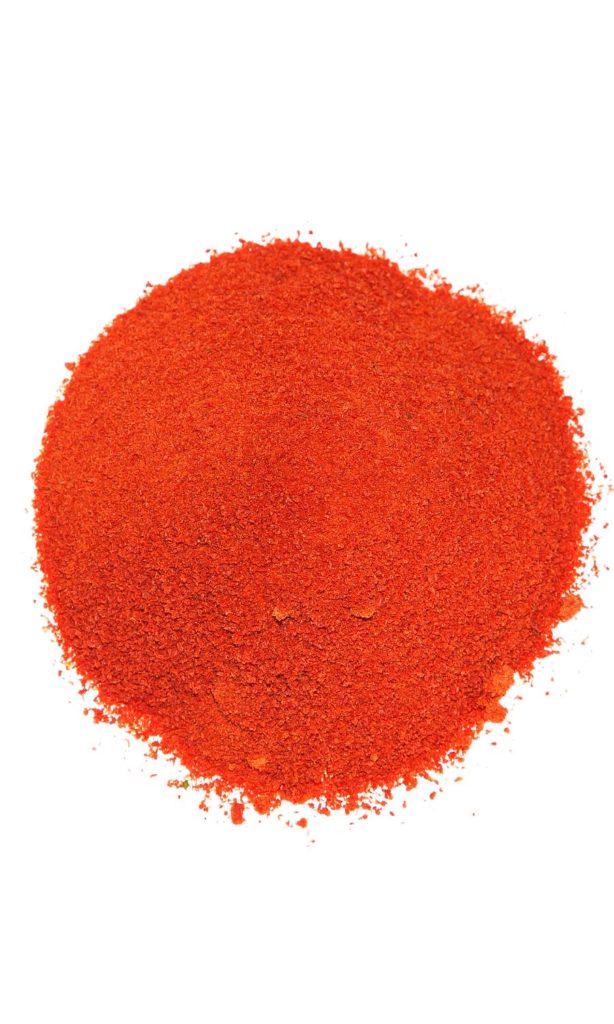Beta-carotene can be converted into vitamin A making carotene in dog food part of a healthy diet. Since carotenes are also natural pigments, they can be used to add color to dog food.
Contents
What Are Carotenes?
Carotenes are a class of phytochemicals. They are found in leafy vegetables since they play a role in photosynthesis.
Since carotenes are yellow-red pigments they are also found in many yellow, orange, or red fruits and vegetables.

Carotenes are named after carrots which contain lots of β-carotene causing this vegetable’s typical orange color.
Tomato lycopene is another form of carotene. And there are several hundred more that we know about today.
Together with yellow pigments called xanthophylls, carotenes are part of a larger group called carotenoids.
These phytonutrients are associated with many health benefits, have antioxidant properties, and can stimulate the immune response[5,9].
Carotenes are found in many leafy greens, fruits, and vegetables:
| Food Item | Beta-carotene | Lycopene |
|---|---|---|
| Sweet Potatoes | 8509 μg | |
| Carrots | 8285 μg | |
| Spinach | 5626 μg | |
| Parsley | 5054 μg | |
| Turnip Greens | 4575 μg | |
| Collard Greens | 4513 μg | |
| Garden Cress | 4150 μg | |
| Cilantro | 3930 µg | |
| Beet Greens | 3790 µg | |
| Swiss Chard | 3652 μg | |
| Basil | 3142 μg | |
| Pumpkin | 3100 μg | |
| Bok Choy | 2681 μg | |
| Chives | 2612 μg | |
| Rose Hips | 2350 µg | 6800 µg |
| Cantaloupe | 2020 μg | |
| Lettuce | 1987 μg | |
| Watercress | 1914 μg | |
| Mustard Greens | 1790 µg | |
| Bell Pepper | 1624 μg | |
| Apricots | 1094 μg | |
| Winter Squash | 820 μg | |
| Grapefruit | 686 µg | 1419 µg |
| Zucchini | 670 μg | |
| Mango | 640 μg | |
| Tomatoes | 449 μg | 2573 μg |
| Green Peas | 449 μg | |
| Asparagus | 449 μg | |
| Guava | 374 μg | 5204 µg |
| Broccoli | 361 μg | |
| Water Melon | 303 μg | 4532 μg |
| Papaya | 274 μg | 1828 µg |
| Persimmon | 253 μg | |
| Acorn Squash | 220 μg | |
| Peach | 162 μg | |
| Summer Squash | 120 μg | |
| Cinnamon (dry, ground) | 112 µg | 15 µg |
| Alfalfa Sprouts | 87µg | |
| Kelp | 70 µg | |
| Avocado | 62 µg | |
| Kiwifruit | 52 µg | |
| Corn | 47 µg | |
| Spirulina | 33 µg | |
| Blueberries | 32 µg | |
| Apples | 27 μg | |
| Pears | 14 µg |
Beta-Carotene In Dog Food
Beta-carotene is just one of many naturally occurring carotenes but one of the most important in terms of dog nutrition.
You will find many dog food recipes that include beta-carotene in their ingredient lists.
That’s because dogs can use an enzyme to convert β-carotene into vitamin A. So, in other words, β-carotene acts as a vitamin A precursor.
Dogs can meet their dietary vitamin A requirements by eating preformed vitamin A from animal sources or just from provitamin A carotenoids from plant ingredients[8].
And they should since vitamin A is an essential nutrient!
This fat-soluble vitamin is important for vision, reproduction, skin and mucous membranes, growth, and your dog’s immune function.

Feeding experiments have shown that dogs can absorb β-carotene and use it as their sole source of vitamin A[1].
However, we don’t exactly know how efficiently dogs can actually convert beta-carotene to vitamin A.
But we do know they are better at it than cats or ferrets. That makes sense given that dogs are omnivores and their ancestors consumed way more plant material compared to carnivores.
Carotenes are generally recognized as safe when used as nutritional food additives[2]. And there are many dog foods with beta carotene used as a Vitamin A supplement.
Other carotenoids such as α-carotene or cryptoxanthin may also have provitamin A activity in dogs[3]. But these are much less well understood.
Although carotenes are in general considered safe and healthy, an excessive intake may have unknown effects. We recommend asking your vet before supplementing your dog’s diet.
Did you know dogs can get carotenemia?
This is a reversible and harmless clinical condition causing the skin to turn yellow as a result of prolonged and excessive β-carotene consumption!
Carotene As Food Additive
Since carotenes are natural pigments they are also used for food coloring.
Typically, beta-carotene used for this purpose seems to be extracted from natural sources like carrots or palm fruit oil[4].
Beta-carotene is also obtained from green micro-algae like Dunaliella salina and Dunaliella bardawil[7].
Another carotene occasionally used as a color additive is tomato lycopene, a potent antioxidant, and red-colored pigment.

Microorganisms like Blakeslea trispora, a mold fungus, can produce large amounts of (synthetic) β-carotene and lycopene.
Since carotenes are considered safe, they do not have to be listed individually on the dog food label. Instead, manufacturers only need to indicate that “added colors” or “artificial colors” were used.
Further Reading
[1] Green et al. Meeting the Vitamin A Requirement: The Efficacy and Importance of β-Carotene in Animal Species. The Scientific World Journal. 2016. https://doi.org/10.1155/2016/7393620
[2] Code of Federal Regulations. Title 21.
Nutritional Additives: 21 CFR §582.5245 Carotene.
Color Additives: 21 CFR §73.585 Tomato Lycopene.
[3] Tanprasertsuk et al. Roles of plant-based ingredients and phytonutrients in canine nutrition and health. J Anim Physiol Anim Nutr. 2022. https://doi.org/10.1111/jpn.13626
[4] EFSA Panel on Food Additives and Nutrient Sources. Scientific opinion on the re-evaluation of mixed carotenes (E 160a (i)) and beta-carotene (E 160a (ii)) as a food additive. EFSA J. 2012. https://doi.org/10.2903/j.efsa.2012.2593
[5] Massimino et al. Effects of age and dietary beta-carotene on immunological variables in dogs. J Vet Intern Med. 2003. https://doi.org/10.1111/j.1939-1676.2003.tb02523.x
[6] U.S. Department of Agriculture. Agricultural Research Service. FoodData Central. 2019. fdc.nal.usda.gov
[7] Hosseini Tafreshi A, Shariati M. Dunaliella biotechnology: Methods and applications. J Appl Microbiol. 2009. https://doi.org/10.1111/j.1365-2672.2009.04153.x
[8] Green & Fascetti. Meeting the vitamin A requirement: the efficacy and importance of β-carotene in animal species. The Scientific World Journal. 2016. https://doi.org/10.1155/2016/7393620
[9] Chew et al. Dietary beta-carotene stimulates cell-mediated and humoral immune response in dogs. J Nutr. 2000. https://doi.org/10.1093/jn/130.8.1910
[10] Beynen. 2019. Carotenoids in petfood.
[11] Chew et al. Dietary β-carotene is taken up by blood plasma and leukocytes in dogs. J Nutr. 2000. https://doi.org/10.1093/jn/130.7.1788
